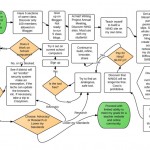As a special education teacher, I’m constantly on the look out for time savers that help me accomplish my massive workload in less time. There are so many things to do in special education! (Regular ed teachers, I know you’ve got a lot going on, too!) In addition to the instructional planning, teaching, data collection, data analysis, and family communication that we all do as teachers, special education teachers also have the responsibility of maintaining an Individualized Education Plan (IEP) for each student and holding an annual IEP review meeting with the student’s educational team. From start to finish, each IEP takes me anywhere from 1-4 hours depending on the student’s strengths/needs, collaboration with others, and the length of the actual IEP meeting. So far this year, I’ve held 20 IEP meetings—and I’ll have at least 8 more before the end of the year. (This doesn’t even include all the IEP meetings that I attend in another role like “regular education teacher” or “district representative.”) I’m sure you can see why saving time is high on my priority list!
When I switched to a new school district this year, I was interested to learn it’s a district policy for special education teachers to send an IEP draft home to families prior to the IEP meeting. If I’m being honest, I think I groaned a little bit about the idea of getting an IEP finished early enough to send home a draft. (I can certainly think of late nights in my special education career when I was working on an IEP for the next day). Looking back on this year so far, I have seen tremendous benefits from sending home IEP drafts before meetings!
First, I think sending home an IEP draft increases family involvement in IEP meetings. Families have a chance to read over the present levels to know more about how their child is doing academically, socially, and in communication and motor areas. Since other members of the IEP team (i.e. teacher(s), speech therapist, occupational therapist, and/or physical therapist) already know how the child is doing in these areas, I think it creates balance and equality at the IEP table for parents to have this information to consider and reflect in advance. This enables both parents to review the document if only one can attend the meeting so that all perspectives can be included. I think sending home an IEP draft is especially important because IEP meetings can be overwhelming for families. Providing a draft allows families to review information in a stress-free environment and may also give them a chance to use accommodations or seek help if they have their own special learning needs.
Second, it saves the IEP team time if parents have read the present levels in the IEP draft before the IEP meeting. When parents don’t have the IEP in advance, the team has to review detailed present levels in all areas including: reading, writing, math, communication, social skills, adaptive skills, and physical development. This can easily be a 20-minute conversation, and it’s one of the most important parts of the meeting because the team needs to talk about how the student is doing before the team can discuss challenging goals for the next IEP year. When parents have reviewed this information before the meeting, it saves time because the team can touch on highlights without reviewing every detail. In my opinion, this really values the professional time of IEP team members. The teacher and related service providers already know how the student is doing, so the detailed review of present levels mostly serves only the parent. When the parent has this information to review in advance, I think it saves about 15 minutes per meeting. I really appreciate saving time, and I think my colleagues do, too! Considering how busy parents are today, I’m guessing that parents appreciate the shorter meeting as well.
Third, when the IEP team can save time in areas like discussing present levels, the team can devote time to more important matters. There is more time to talk about how things are going at home, discuss and solve problems as a team, answer parent questions, or provide ideas to increase the child’s progress at home. I think this collaboration time is invaluable. Since the IEP team typically only gathers once per year, I think it’s important to use the time wisely. I believe the parent is the most knowledgeable expert at the IEP table (because they know their child best), so I like to hear from families as much as possible. This often gives me new ideas to motivate their child or helps me better understand why the child learns or responds in a certain way. Sending home the IEP draft gives me time so that I can maximize the time together during the meeting.
Overall, I think sending home IEP drafts prior to IEP meetings is a great practice for families and education professionals. If this is something you haven’t tried, you might consider asking a special education adviser/administrator for permission to try it and see if you find benefits as well. One word of caution: It’s very important to clearly indicate that it’s a “DRAFT” on the top of the document and include a note telling families how much you are looking forward to their input in revising the draft. Also, I don’t recommend including any big changes that still need to be discussed as a team. For example, if the team is considering changing the placement of the student to another setting, it might be better to leave the section blank in the draft or write a phrase like “Update at meeting” in the section to be discussed. Technically, decisions like that should always be made as an IEP team with the parents’ input, and you don’t want to look as though you have predetermined the outcome. Check with your special education administrators if you need additional guidance to ensure that sending home IEP drafts benefits your colleagues and the families you serve.
If you have tips that save you time in special education, share them in the comments section below! And don’t forget to share your opinions about working conditions in the TELL Arizona survey from now until April 28. (Get your code from your administrator.) This is a great chance for all Arizona teachers to be heard!
Image credit: https://pixabay.com/en/hourglass-sand-watch-time-glass-1046841/










Comments 3
Thanks for posting this, Jess! This is a requirement in our district as well, although some teachers do not understand the importance of it! We began this a few years ago to increase parent involvement, since parent input is so important to the IEP process. Our first step is asking for parent input, then we add that to the draft IEP along with our input. We send that home for the parent to review before the meeting. I agree it makes the meetings go faster, since you can get right to the parts where there needs to be discussion.
Jess thanks for sharing such a practical way to save time and increase engagement with parents. It is great that something so easily done, can not only build relationships but value others time as well. Thanks for sharing your experience and advice! I made sure to share this with my SPED colleagues.
Thank you, Jess.